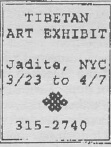| The following article is from the Winter, 1993 issue of the Snow Lion Newsletter and is for historical reference only. You can see this in context of the original newsletter here. |
by Namkhai Norbu
Review by Diane Shainberg
Reprinted from Tricycle: The Buddhist Review$14.95
Snow Lion Publications
Dream Yoga and the Practice of Natural Light addresses the possibilities of lucid dreaming. Tibetan author Namkhai Norbu, an internationally respected teacher of the Vajrayana traditions of tantra and dzogchen, instructs as well on evoking passages into natural light (a non-conceptual display of consciousness) after falling asleep but before dreams begin. The introduction, beautifully written by Michael Katz, provides a historical account of the relevance of dreams and their value in several different cultures. It also emphasizes the importance of awakeness during both sleep and dreaming.
The book is particularly attuned to those practitioners sincere about awakening. In Katz' interview with Namkhai Norbu, the practices of the night and their relation to awareness of our real nature in the day may challenge our ideas about practice in provocative ways. Awareness in dreamtime means maintaining the awareness we have found in meditation and in the contemplative state known in dzogchen as rigpa. The state must be established before spiritual growth can occur in sleep and dreaming. If a person has no capacity to be in rigpa, nighttime practices cannot be used as a means of liberation. But for the practitioner accomplished by day, sleep offers the possibility of roaming freely in dreams into the future and also to receive the clarity of the Buddhist teachings. One is also free to receive messages of past teachings, to meet deities, and to discover old teachings from masters.
The awareness that one can maintain in dreams of the fact that one is dreaming can then be applied to the illusory nature of all phenomena, be it associated with daytime or nighttime visions. In this way, lucid dreaming encourages the liberation from attachment to confusion, anxiety and to all conditioned thinking.
Nighttime and daytime practices work in tandem; the benefits of either one can be applied to the practices of the other. But dream-life in particular encourages a liberation from duality and attachment. Namkhai Norbu Rinpoche makes it clear that if one wants to use sleep and dream experience as one's path and use it in preparation for awakened living or to prepare for such an awakening, or to use it at death, or after dying, one must receive transmission from a tantric or dzogchen teacher. But he also provides practices for those with previous experience of Buddha-nature, which describe in detail the process of seeing natural light. The experiences of the lights can be self-induced as a means to liberate us now, as well as during the process of dying, or after. He makes it clear that there is a relation between bardo states and the levels of consciousness we experience with sleeping and dreaming.
Describing the true nature of mind, Namkhai Norbu ends the book with a poem by Nyingma meditation master Mipham Rinpoche (1846-1914):
That which is called samsara is mere conceptualization.
The great wisdom is free from all conceptualization.
At this time whatever arises manifests as completely perfect.
The state of great clear light is continuous day and night.


